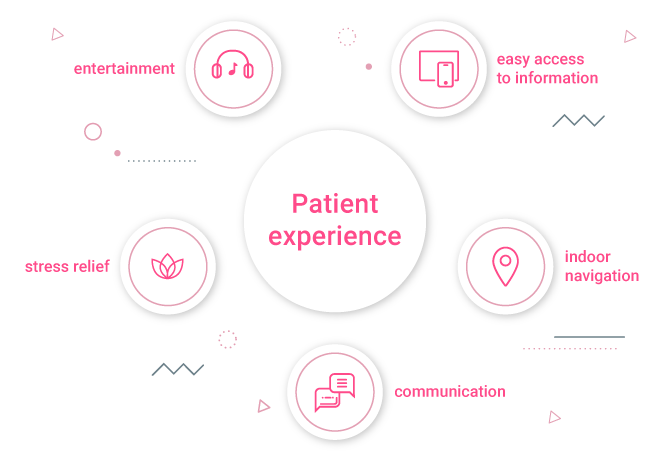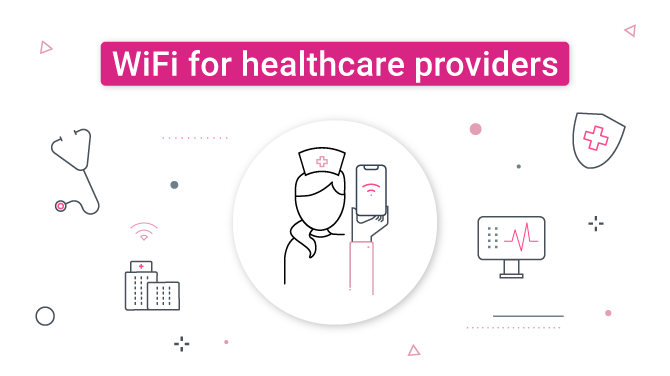It should come as no surprise to anyone that, after 2020, deployments in healthcare have become a major trend for guest WiFi. Despite the growing popularity of the so-called telemedicine, facilities like hospitals, clinics, and surgeries have experienced unprecedented spikes in the number of visitors. And with that came the need to accommodate them better, especially in the private sector where facilities depend on their own funding. WiFi for healthcare providers is one of the ways in which the providers can achieve that. So how does it help doctors, nurses, patients, and visitors? In this blog we’ve collected all the ways in which they benefit, so that you can make up your mind whether to implement it, too.
Social distancing
“Social distancing” entered our dictionaries in 2020 and quickly became a buzzword. Nowhere is this concept more important than in healthcare, where the chances of catching an airborne disease rise exponentially. This is why healthcare providers started to look into the ways in which they can monitor occupancy and enforce physical distancing.
Among the many more or less effective solutions is WiFi. After all, almost everyone has a smartphone. And if its WiFi is on (whether they are connected to any network or not), it sends out a signal searching for available networks. This allows guest WiFi owners to count how many people there are in their building. It also tells them in which part of the building these people are, based on the strength of the signal the access point receives.
With the right software, such as Linkyfi Social Distancing and Occupancy Management, hospitals and clinics can even receive alerts when there are too many people in any given place. This way hospital staff doesn’t waste precious time having to continuously monitor the situation. They can simply intervene when alerted to the problem!

Another way in which healthcare providers use WiFi to improve physical distancing is to analyze movement patterns across time. They can see points of entrance and exit, the most common paths people take to get from point A to B, and places where they tend to crowd. That’s a start for introducing changes that redirect traffic and spread it more evenly. For example, they can designate one-way corridors in and out of the building – when people use a different entrance than the exit, they will not crowd as much at one point.
Patient experience
For those patients and visitors who do log into the hospital network, WiFi for healthcare providers offers even more benefits as it can significantly improve the experience that the patients have when visiting the facility.
First of all, mere access to the internet is a form of relief both for patients and visitors. These days, hardly anyone can go a day (not to mention a week or a month!) without internet access. Some even suffer from mild “withdrawal,” and experience physical and mental discomfort when forced to do so. Many hospital patients depend on the connection to occupy their time on the ward, streaming music, podcasts, movies and TV series, or reading online. What’s more, with the growing popularity of remote employment, many people choose to work even when in the hospital to take their mind off of that rather unpleasant experience. Finally, for long-term patients who are being treated far away from their home and for quarantined patients as well, virtual contact on video-chats is the only form of staying in touch with their friends and families. All these factors can affect the patients and for all these purposes they need internet access.
On the other hand, it is no less useful for hospital visitors and patients at the clinics, as it can ease the tension they experience while waiting for their visit, an exam, or a procedure. And it doesn’t even need to be explained how internet access can help doctors and nurses to easily pull patient information and keep their records up to date.

It is therefore important for healthcare providers to have the means to effectively manage their WiFi. After all, everyone has different needs. Doctors should have higher priority access than other users; patients will naturally use more bandwidth than visitors etc. With the right WiFi management platform, healthcare providers can set up different SSIDs for different users, so that the doctors don’t have to use the same network as the visitors. They can also set up different login methods, so for example a visitor will log in without providing any credentials, meanwhile, a patient will use a specially generated token to have more and faster bandwidth.
Depending on how advanced the software is, there are many other ways in which WiFi for healthcare providers can improve the patient experience. Some of these include:
- indoor navigation: if the platform also has a location engine, it can be used to locate and guide people around the venue. It is especially easy to get lost in a sterile maze of identical hospital corridors, just as it is especially difficult to find the right doctor’s office in a large clinic. Meanwhile, hospitals and clinics can easily fix that problem by providing their visitors with navigation apps – similar to what you can find in shopping malls;
- additional communication channels: WiFi landing pages and splash pages are a great place to share important information with visitors. Whether it’s reminders to put a mask on or announcements about free vaccination programs – you can be sure everyone will see them just as soon as they drop down their head to log into the network!
Asset tracking
Finally, WiFi for healthcare providers can be used to simply keep things in order. Facilities can turn their networks into tools for tracking various assets, such as hospital beds, portable ultrasounds, etc. This way, they will always know where to find them – even on most hectic days.
And while it’s probably improper to speak of “asset tracking” in terms of people, that’s in fact what doctors and nurses are – healthcare’s biggest assets! WiFi tracking can be used to keep up with where they are without having to actually bother them. Imagine a situation where a doctor on call is needed on the ward, but they’re nowhere to be found and no way to be reached, because they’re tending to another patient in the ER. These are the kinds of situations where modern technologies – ones that you already have on your hands! – can help.
Is WiFi a necessity for healthcare providers?
As you can see, there’s a myriad of ways in which WiFi for healthcare providers can help both doctors and patients. The key to achieve that? There are in fact two. First, they need to realize how valuable it is for their daily operations, and how easy it is to implement the solutions we discussed using WiFi. And second are the right tools. A simple WiFi management platform will be just that – a piece of software to broadcast the signal. But a robust software that comprises location and analytics on top of extensive access management features can save healthcare providers a lot of work and make the patient experience that much better.
